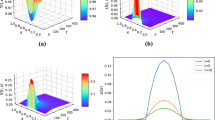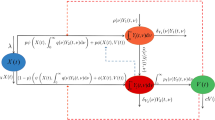Abstract
In this paper, we propose two HIV infection models with specific nonlinear incidence rate by including a class of infected cells in the eclipse phase. The first model is described by ordinary differential equations (ODEs) and generalizes a set of previously existing models and their results. The second model extends our ODE model by taking into account the diffusion of virus. Furthermore, the global stability of both models is investigated by constructing suitable Lyapunov functionals. Finally, we check our theoretical results with numerical simulations.




Similar content being viewed by others
References
Adnani J, Hattaf K, Yousfi N (2013) Stability analysis of a stochastic SIR epidemic model with specific nonlinear incidence rate. Int J Stoch Anal Article ID 431257, 4 p
Bajaria SH, Webb G, Cloyd M, Kirschner D (2002) Dynamics of naive and memory CD4+ T lymphocytes in HIV-1 disease progression. J Acquir Immune Defic Syndr 30:41–58
Beddington JR (1975) Mutual interference between parasites or predators and its effect on searching efficiency. J Anim Ecol 44:331–340
Bourgeois C, Hao Z, Rajewsky K, Potocnik AJ, Stockinger B (2008) Ablation of thymic export causes accelerated decay of naive CD4 T cells in the periphery because of activation by environmental antigen. Proc Natl Acad Sci 105(25):8691–8696
Buonomo B, Vargas-De-León C (2012) Global stability for an HIV-1 infection model including an eclipse stage of infected cells. J Math Anal Appl 385:709–720
Chen L, Hattaf K, Sun J (2015) Optimal control of a delayed SLBS computer virus model. Phys A Stat Mech Appl 427:244–250
Chen JJY, Cloyd MW (1999) The potential importance of HIV-induction of lymphocyte homing to lymph nodes. Int Immunol 11(10):1591–1594
Crowley PH, Martin EK (1989) Functional responses and interference within and between year classes of a dragonfly population. J North Am Benthol Soc 8:211–221
Cuifang Lv, Huang L, Yuan Y (2014) Global stability for an HIV-1 infection model with Beddington–DeAngelis incidence rate and CTL immune response. Commun Nonlinear Sci Numer Simul 19:121–127
De Boer RJ, Ribeiro RM, Perelson AS (2010) Current estimates for HIV-1 production imply rapid viral clearance in lymphoid tissues. Plos Comput Biol 6(9):e1000906
DeAngelis DL, Goldstein RA, O’Neill RV (1975) A model for trophic interaction. Ecology 56:881–892
Essunger P, Perelson AS (1994) Modeling HIV infection of CD4+ T-cell subpopulations. J Theor Biol 170(4):367–391
Hattaf K, Yousfi N, Tridane A (2013) Stability analysis of a virus dynamics model with general incidence rate and two delays. Appl Math Comput 221:514–521
Hattaf K, Yousfi N (2013) Global stability for reaction–diffusion equations in biology. Comput Math Appl 66:1488–1497
Hattaf K, Yousfi N (2014) Global dynamics of a delay reaction–diffusion model for viral infection with specific functional response. Comput Appl Math. doi:10.1007/s40314-014-0143-x
Hattaf K, Yousfi N (2015) A generalized HBV model with diffusion and two delays. Comput Math Appl 69:31–40
Henry D (1993) Geometric theory of semilinear parabolic equations, vol 840 of Lecture notes in mathematics. Springer, Berlin
Hill AL, Rosenbloom DIS, Fu F, Nowak MA, Siliciano RF (2014) Predicting the outcomes of treatment to eradicate the latent reservoir for HIV-1. Proc Natl Acad Sci USA 111:13475–13480
Ho DD, Neumann AU, Perelson AS, Chen W, Leonard JM, Markowitz M (1995) Rapid turnover of plasma virions and CD4 lymphocytes in HIV-1 infection. Nature 373:123–126
Hu Z, Pang W, Liao F, Ma W (2014) Analysis of a CD4+ T cell viral infection model with a class of saturated infection rate. Discret Contin Dyn Syst Ser B 19(3):735–745
Huang G, Ma W, Takeuchi Y (2009) Global properties for virus dynamics model with Beddington–DeAngelis functional response. Appl Math Lett 22:1690–1693
Huang G, Ma W, Takeuchi Y (2011) Global analysis for delay virus dynamics model with Beddington–DeAngelis functional response. Appl Math Lett 24(7):1199–1203
LaSalle JP (1976) The stability of dynamical systems. In: Regional conference series in applied mathematics. SIAM, Philadelphia
Lotfi EM, Maziane M, Hattaf K, Yousfi N (2014) Partial differential equations of an epidemic model with spatial diffusion. Int J Partial Differ Equ Article ID 186437, 6 p
Nowak MA, Bonhoeffer S, Shaw GM, May R (1997) Anti-viral drug treatment: dynamics of resistance in free virus and infected cell populations. J Theor Biol 184:203–217
Nowak MA, Bangham CRM (1996) Population dynamics of immune responses to persistent viruses. Science 272:74–79
Nowak MA, May RM (2000) Virus dynamics: mathematical principles of immunology and virology. Oxford University Press, New York
Pazy A (1983) Semigroups of linear operators and applications to partial differential equations, vol 44 of applied mathematical sciences. Springer, New York
Perelson AS (1989) Modeling the interaction of the immune system with HIV. In: Castillo-Chavez C, (ed) Mathematical and statistical approaches to AIDS epidemiology (Lect. Notes Biomath., vol 831). Springer, New York, pp 350–370
Perelson AS, Kirschner DE, De Boer R (1993) Dynamics of HIV Infection of CD4+ T cells. Math Biosci 114:81–125
Perelson AS, Neumann AU, Markowitz M, Leonard JM, Ho DD (1996) HIV-1 dynamics in vivo: virion clearance rate, infected cell life-span, and viral generation time. Science 271:1582–1586
Protter MH, Weinberger HF (1967) Maximum principles in differential equations. Prentice Hall, Englewood Cliffs
Rong L, Gilchrist MA, Feng Z, Perelson AS (2007) Modeling within-host HIV-1 dynamics and the evolution of drug resistance: trade-offs between viral enzyme function and drug susceptibility. J Theor Biol 247:804–818
Smoller J (1983) Shock waves and reaction–diffusion equations. Springer, Berlin
Stafford MA, Corey L, Cao Y, Daar ES, Ho DD, Perelson AS (2000) Modeling plasma virus concentration during primary HIV infection. J Theor Biol 203(3):285–301
Touzeau S, Gouzé J-L (1998) On the stock–recruitment relationships in fish population models. Environ Model Assess 3:87–93
Tsai WP, Conley SR, Kung HF, Garrity RR, Nara PL (1996) Preliminary in vitro growth cycle and transmission studies of HIV-1 in an autologous primary cell assay of bloodderived macrophages and peripheral blood mononuclear cells. Virology 226:205–216
Uppal SS, Verma Shashi, Dhot PS (2003) Normal values of CD4 and CD8 lymphocyte subsets in healthy Indian adults and the effects of sex, age, ethnicity, and smoking. Cytom Part B Clin Cytom 52(1):32–36
Wang L, Chen JJY, Gelman BB, Konig R, Cloyd MW (1999) A novel mechanism of CD4 lymphocyte depletion involves effects of HIV on resting lymphocytes: induction of lymph node homing and apoptosis upon secondary signaling through homing receptors. J Immunol 162:268–276
Wei X, Ghosh SK, Taylor ME et al (1995) Viral dynamics in human immunodeficiency virus type 1 infection. Nature 373:117–122
Zhou X, Cui J (2011) Global stability of the viral dynamics with Crowley–Martin functional response. Bull Korean Math Soc 48(3):555–574
Acknowledgments
We would like to thank the editor and three anonymous referees for their very helpful comments and suggestions that greatly improved the quality of this work.
Author information
Authors and Affiliations
Corresponding author
Rights and permissions
About this article
Cite this article
Maziane, M., Lotfi, E.M., Hattaf, K. et al. Dynamics of a Class of HIV Infection Models with Cure of Infected Cells in Eclipse Stage. Acta Biotheor 63, 363–380 (2015). https://doi.org/10.1007/s10441-015-9263-y
Received:
Accepted:
Published:
Issue Date:
DOI: https://doi.org/10.1007/s10441-015-9263-y




